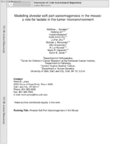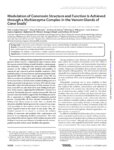|
|
Creator | Title | Description | Subject | Date |
| 376 |
 |
Capecchi, Mario R. | Modeling alveolar soft part sarcomagenesis in the mouse: a role for lactate in the tumor microenvironment | Alveolar soft part sarcoma (ASPS), a deadly soft tissue malignancy with a predilection for adolescents and young adults, associates consistently with t(X;17) translocations that generate the fusion gene ASPSCR1-TFE3. We proved the oncogenic capacity of this fusion gene by driving sarcomagenesis in m... | | 2014-01-01 |
| 377 |
 |
Seger, Jon | Models of sex ratio evolution | Our understanding of sex ratio evolution depends strongly on models that identify: (1) constraints on the production of male and female offspring, and (2) fitness consequences entailed by the production of different attainable brood sex ratios. Verbal and mathematical arguments by, among others, D... | Fitness; Species; Sex-allocation | 2002 |
| 378 |
 |
Olivera, Baldomero M. | Modulation of conotoxin structure and function is achieved through a multienzyme complex in the venom glands of cone snails | Background: Conotoxins can be utilized to investigate enzyme-assisted folding of disulfide-rich peptides. Results: Various ER-resident cone snail enzymes act in concert to accelerate the oxidative folding of conotoxins and modulate their conformation by reconfiguring disulfide connectivities. Conclu... | | 2012-01-01 |
| 379 |
 |
Jorgensen, Erik | Molecular basis of synaptic vesicle cargo recognition by the endocytic sorting adaptor stonin 2 | Synaptic transmission depends on clathrin-mediated recycling of synaptic vesicles (SVs). How select SV proteins are targeted for internalization has remained elusive. Stonins are evolutionarily conserved adaptors dedicated to endocytic sorting of the SV protein synaptotagmin. Our data identify the m... | | 2007 |
| 380 |
 |
Beckerle, Mary C. | Molecular characterization of human zyxin | Zyxin is a component of adhesion plaques that has been suggested to perform regulatory functions at these specialized regions of the plasma membrane. Here we describe the isolation and characterization of cDNAs encoding human and mouse zyxin. | Zyxin; Proline; LIM domains | 1996 |
| 381 |
 |
Beckerle, Mary C. | Molecular dissection of a LIM domain | LIM domains are novel sequence elements that are found in more than 60 gene products, many of which function as key regulators of developmental pathways. The LIM domain, characterized by the cysteine-rich consensus CX2CX16_23HX2CX2CX2CX16_21CX2-3(C/H/ D), is a specific metal-binding structure tha... | LIM domains; Metal-binding; Zyxin; Cysteine-rich proteins | 1997 |
| 382 |
 |
Beckerle, Mary C. | Molecular dissection of zyxin function reveals its involvement in cell motility | Spatially controlled actin filament assembly is critical for numerous processes, including the vectorial cell migration required for wound healing, cell-mediated immunity, and embryogenesis. One protein implicated in the regulation of actin assembly is zyxin, a protein concentrated at sites where t... | Zyxin; Actinin; Ena/VASP | 1999 |
| 383 |
 |
Olivera, Baldomero M.; Bandyopadhyay, Pradip K. | Molecular phylogeny of some Indo-Pacific genera in the subfamily Turrinae H. Adams and A. Adams, 1853 (1838) (Gastropoda: Neogastropoda) | We have carried out a phylogenetic analysis of a group of Indo-Pacific species in the subfamily Turrinae (Swainson, 1840) using 128 mitoehondrial ribosomal RNA gene sequcnces Most of the species analyzed are convenlionally assigned to one of there Lophiotoma Casey, 1904. The inolecular anaysis revea... | Turrinae; Indo-Pacific; Mitochondrial RNA; Molecular phylogeny | 2007 |
| 384 |
 |
Clayton, Dale H. | Molecular phylogeny of the dove genera Streptopelia and Columba | Evolutionary history of the dove genus Streptopelia has not been examined with rigorous phylogenetic methods. We present a study of phylogenetic relationships of Streptopelia based on over 3,600 base pairs of nuclear and mitochondrial gene sequences. | Doves; Streptopelia; Columba | 2001 |
| 385 |
 |
Clayton, Dale H. | Molecular phylogeny of the dove genus Zenaida: mitochondrial and nuclear DNA sequences | We reconstructed a phylogeny for the seven species of doves in the genus Zenaida on the basis of a combined analysis of mitochondria (ND2 and cytochrome b) and nuclear (fibrinogen intron 7) DNA sequences. This phylogeny, which is completely resolved, is well supported with all nodes showing greater... | Molecular phylogeny; Dove; Nuclear DNA | 2000 |
| 386 |
 |
Bohs, Lynn A. | Molecular phylogeny of the Solanaceae | A phylogeny of Solanaceae is presented based on the chloroplast DNA regions ndhF and trnLF. With 89 genera and 190 species included, this represents a nearly comprehensive genus-level sampling and provides a framework phylogeny for the entire family that helps integrate many previously-published phy... | Biogeography; Chloroplast DNA; Chromosome evolution; ndhF; trnLF | 2008 |
| 387 |
 |
Blair, David F. | MotA protein of E. coli is a proton-conducting component of the flagellar motor | A number of mutants of motA, a gene necessary for flagellar rotation in E. coli, were isolated and characterized. Many mutations were dominant, owing to competition between functional and nonfunctional MotA for a limited number of sites on the flagellar motor. A new class of mutant was discovered... | MotA protein; MotA gene; Flagellar motor; Proton-conducting | 1990 |
| 388 |
 |
Goller, Franz | Motor control of crystallized song is modified by sensory feedback | Song production requires precisely coordinated activity in the respiratory and syringcal (vocal organ) muscles. Crystallized adult song is characterized by acoustic and motor stereotypy which does not require auditory feedback, suggesting it is represented by fixed central motor programs. To determ... | Air injection; Auditory feedback; Pressure | 1997 |
| 389 |
 |
Goller, Franz | Motor control of sound frequency in birdsong involves the interaction between air sac pressure and labial tension | Frequency modulation is a salient acoustic feature of birdsong. Its control is usually attributed to the activity of syringeal muscles, which affect the tension of the labia responsible for sound production. We use experimental and theoretical tools to test the hypothesis that for birds producing to... | | 2014-01-01 |
| 390 |
 |
Lawton, Kristy J. | Motor neurons tune premotor activity in a vertebrate central pattern generator | Central patterns generators (CPGs) are neural circuits that drive rhythmic motor output without sensory feedback. Vertebrate CPGs are generally believed to operate in a top-down manner in which premotor interneurons activate motor neurons that in turn drive muscles. In contrast, the frog (Xenopus la... | CPG; feed back; synchrony; vocal; vocalization; Xenopus | 2017 |
| 391 |
 |
Eichwald, Ernst; Capecchi, Mario R.; Thomas, Kirk R. | Mouse model for the delta F508 allele of cystic fibrosis | The most common cause of cystic fibrosis is a mutation that deletes phenylalanine 508 in cystic fibrosis transmembrane conductance regulator (CFTR). The delta F508 protein is misprocessed and degraded rather than traveling to the apical membrane. We used a novel strategy to introduce the delta F508 ... | Digestive System; Disease Models, Animal; Electrolytes; Mice, Inbred C57BL | 1995-10 |
| 392 |
 |
Olivera, Baldomero M. | Multiple bromotryptophan and y-carboxyglutamate residues in a Conus peptide | A novel peptide was purified from Conus textile venom which caused hyperactivity in mice. The 31-amino acid peptide has six residues with unusual post-translational modifications: four y-carboxyglutamates and two brominated tryptophan residues. This peptide, which we have designated the dibromorunn... | | 1999-01-01 |
| 393 |
 |
Jorgensen, Erik | Multiple transcripts from the Antennapedia gene of Drosophila melanogaster | The structures of four major transcripts from the homeotic gene Antennapedia of Drosophila melanogaster were determined. These transcripts constitute two RNA classes, each class initiating from a unique promoter but sharing 3' exons. Within the shared sequences is a major open reading frame encoding... | Mutations; Sequences ; RNA | 1986 |
| 394 |
 |
Beckerle, Mary C. | Muscle LIM proteins are associated with muscle sarcomeres and require dMEF2 for their expression during Drosophila myogenesis | A genetic hierarchy of interactions, involving myogenic regulatory factors of the MyoD and myocyte enhancer-binding 2 (MEF2) families, serves to elaborate and maintain the differentiated muscle phenotype through transcriptional regulation of muscle-specific target genes. | LIM domains; Cysteine-rich proteins | 1999 |
| 395 |
 |
Goller, Franz | Muscular control and biomechanics of the songbird syrinx | In songbirds the vocal organ, the syrinx, is controlled by six bilateral muscles, the functional roles of which have been studied indirectly, but not directly. We filmed the syrinx with an endoscope while electrically stimulating individual intrinsic muscles on one side. | Syringeal; Medial labium; Vocal organ | 1997 |
| 396 |
 |
Baehr, Wolfgang; Frederick, Jeanne M.; Church-Kopish, Jill; Howes, Kimberly | Mutant rhodopsin transgene expression on a null background | PURPOSE. To study mechanisms leading to photoreceptor degeneration in mouse models for autosomal dominant retinitis pigmentosa (adRP) based on the rhodopsin P23H mutation. METHODS. Mice of a transgenic line expressing a rhodopsin triple mutant, V20G, P23H, and P27L (GHL), were mated with rhodopsin (... | Mutant Rhodopsin; Photoreceptor Degeneration; Autosomal Dominant Retinitis Pigmentosa; Rhodopsin | 2001-03 |
| 397 |
 |
Beckerle, Mary C.; Davis, Darrell R.; Winge, Dennis R. | Mutational analysis of the metal sites in an LIM domain | Site-directed mutagenesis was carried out map the residues that form the two Zn(I1) sites within a LIM domain. The C-terminal LIM domain derived from the cysteine-rich protein was utilized for this analysis and is referred to as LIMB. | LIM domains; Metal-binding | 1994 |
| 398 |
 |
Parkinson, John Stansfield | Mutational analysis of the P1 phosphorylation domain in E. coli CheA, the signaling kinase for chemotaxis | The histidine autokinase CheA functions as the central processing unit in the Escherichia coli chemotaxis signaling machinery. CheA receives autophosphorylation control inputs from chemoreceptors and in turn regulates the flux of signaling phosphates to the CheY and CheB response regulator proteins... | | 2014-01-01 |
| 399 |
 |
Beckerle, Mary C. | Mutations in Drosophila enabled and rescue by human vasodilator-stimulated phosphoprotein (VASP) indicate important functional roles for Ena/VASP homology domain 1 (EVH1) and EVH2 domains | Drosophila Enabled (Ena) was initially identified as a dominant genetic suppressor of mutations in the Abelson tyrosine kinase and, more recently, as a member of the Ena/human vasodilator-stimulated phosphoprotein (VASP) family of proteins. We have used genetic, biochemical, and cell biological appr... | Drosophila Ena; VASP | 1998 |
| 400 |
 |
Jorgensen, Erik | Mutations in synaptojanin disrupt synaptic vesicle recycling | Synaptojanin is a polyphosphoinositide phosphatase that is found at synapses and binds to proteins implicated in endocytosis. For these reasons, it has been proposed that synaptojanin is involved in the recycling of synaptic vesicles. Here, we demonstrate that the unc-26 gene encodes the Caenorhab... | | 2000 |

























